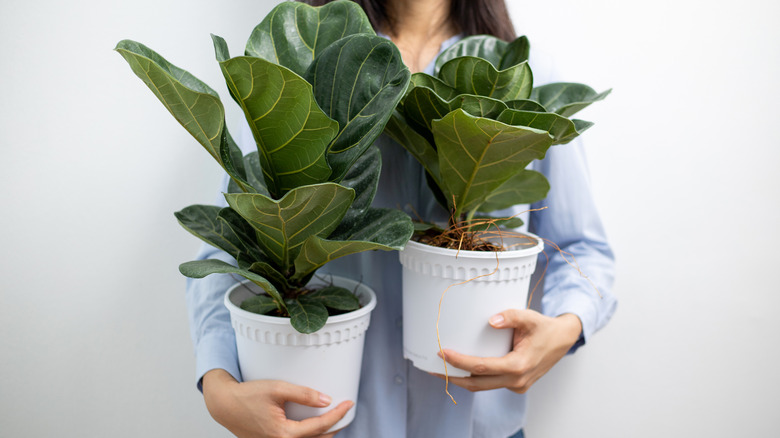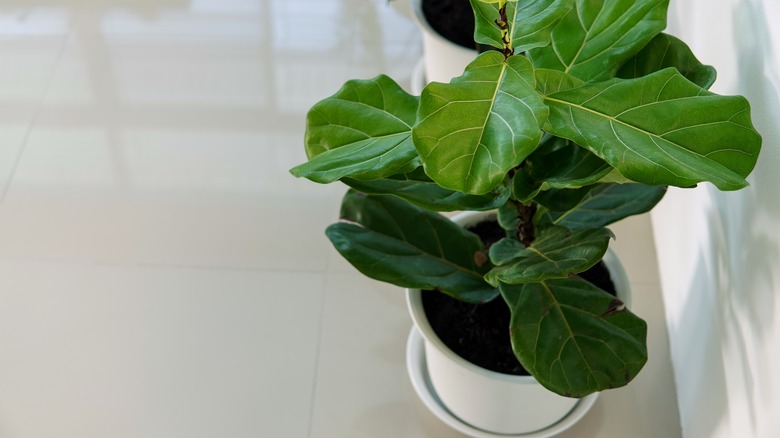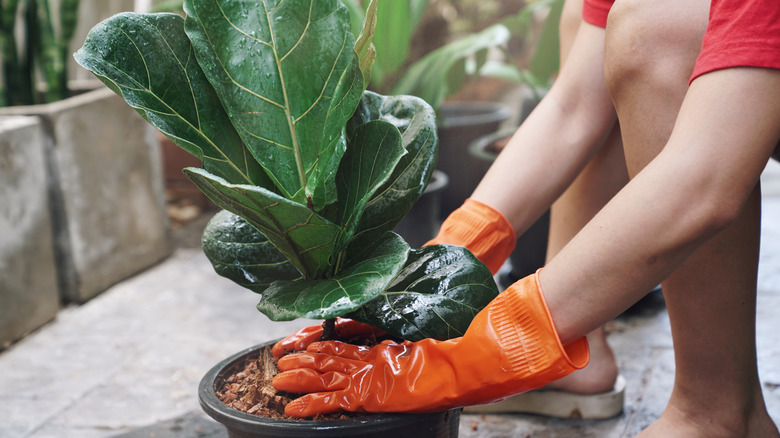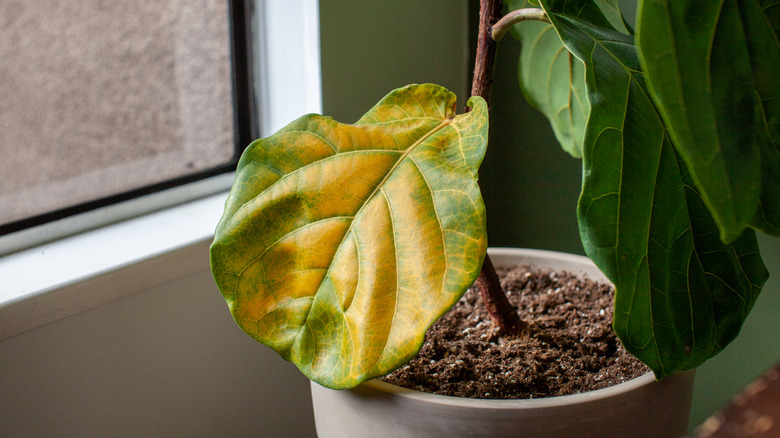You May Want To Rethink How You Fertilize Your Fiddle Leaf Fig
Because of the limited growing space and soil capacity of pots, many houseplants need to be fertilized in order to be able to get all of the nutrients that they need, especially ones with large, thick leaves and branches like the fiddle leaf fig. Large houseplants like the fiddle leaf fig require a lot of nutrients from the soil in order to sustain themselves and continue growing. As such, those nutrients can quickly become depleted and it can be detrimental to the well-being of your plant if those nutrients are not replenished. Fertilizing your fig plant is one of the guaranteed ways to ensure it has access to all the nutrients that it needs so it can grow to its full potential.
Using fertilizer is especially important if it's been a long time since you have last repotted your fig plant, as there's a good chance the soil has already been sapped of all that your plant needs to grow. If your fiddle leaf fig doesn't get the nutrients it needs, you might notice slow or stunted growth, smaller leaves, or a slight yellowing or browning of the leaves. If your plant is deprived enough of nutrients and has no way of getting them, it will eventually die. If your fig is in need of nutrients, using the right kind of fertilizer and using it properly can help contribute to its continued healthy growth.
The right way to fertilize your fiddle leaf fig
When it comes to the nutrient composition of the fertilizer that you should use for your fiddle leaf fig, they prefer something nitrogen-dense with an N-P-K ratio as close as possible to 3:1:2. You might also see fertilizers labeled as 9:3:6, which is the same ratio of nitrogen, phosphorus, and potassium, but in a higher concentration. Regardless of which concentration you use, make sure you follow the instructions on the bottle so you know how much to apply and don't accidentally over-fertilize, which can seriously damage your plant.
If your fiddle leaf fig is in major need of a nutrient boost and you don't have a nitrogen-dense fertilizer, you can use a basic 1:1:1 fertilizer in the meantime, which it should react positively to. Every fertilizer will be a little different, so ensure you are carefully following the instructions on the bottle to guarantee you are using it safely and correctly. Keep in mind that whether you use liquid or pellet fertilizer will also play a role in how you fertilize your fiddle leaf fig plant's soil. Remember that liquid fertilizer will usually need to be diluted into your plant's water to avoid over-fertilizing and chemically burning your fig plant.
How often does your fiddle leaf fig need to be fertilized?
If it's been at least a year since you most recently repotted your fiddle leaf fig and you haven't yet used any fertilizer, it is well overdue, as the soil has likely been depleted of the existing nutrients. While the type of fertilizer you use is up to you and both pellet and liquid fertilizers can help feed your fig plant, they vary slightly in their methods and frequency of application, with liquid fertilizers needing to be applied more often. Begin fertilizing your fig a month after bringing it home if you purchased it in a pot from a nursery or greenhouse and it shows promising signs of growth. If you are repotting your plant, give it a month or two before you resume fertilizing to avoid shocking its already sensitive roots.
Every plant is different, so keep an eye on how your fig reacts to fertilizer. Some will react extremely positively while some will thrive with regular repotting and no fertilization. Keep in mind that the frequency in which you repot your fiddle leaf fig also plays a role in how often you should use fertilizer. If it has been close to a year since you have last repotted your plant and you don't have immediate plans to do so, you will need to incorporate fertilizer as a much more integral part of your maintenance routine than you would if you regularly repotted your fig in fresh potting soil every few months.
Signs your fiddle leaf fig is nutrient deprived
While there are several visible indications that your fiddle leaf fig plant is deprived of essential nutrients, one of the most obvious is a yellowing or browning of the leaves. When your plant isn't able to get all of the vital nutrients that it needs from the soil, it isn't able to produce chlorophyll, which is what enables your plant to grow by providing it with usable energy. The leaves on a fiddle leaf fig that is not properly producing chlorophyll will not be their usual dark green color and may begin to lighten and turn yellow. Not only will your fiddle leaf fig plant be visibly yellow due to the lack of chlorophyll, but it will also be unable to use any of the energy that it is meant to get from the sun. Without chlorophyll and the proper nutrients that your plant needs to get from the soil, it will be unable to survive.
A fiddle leaf fig that lacks nutrients and needs to be fertilized will also appear to be stunted in growth. If your once healthy and thriving fiddle leaf fig plant is suddenly yellowing and you notice that it hasn't gotten any taller or produced any new growth in a while, it's possible it doesn't have access to all of the nutrients that it needs and could benefit from some fertilizer.



